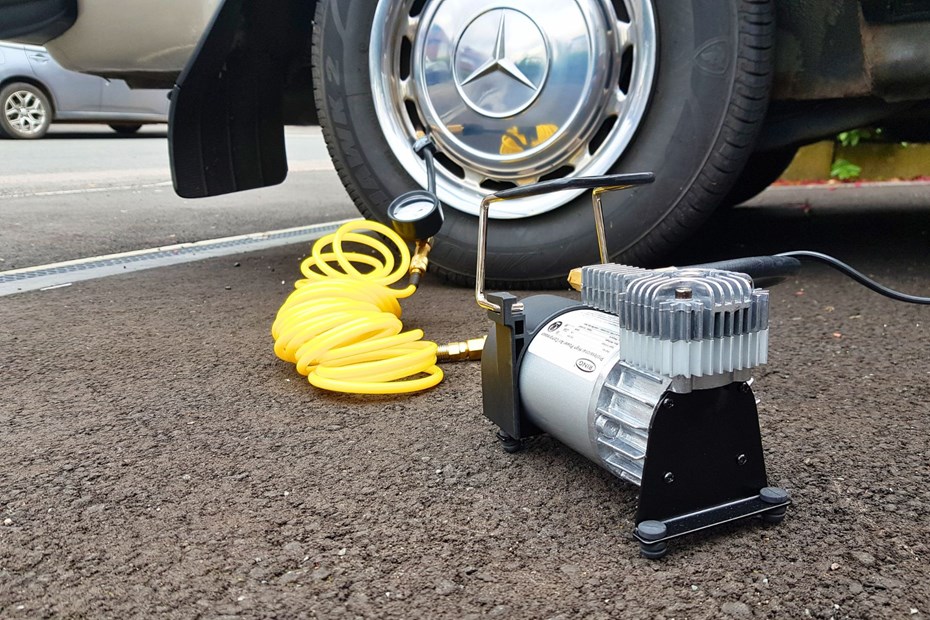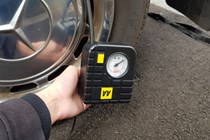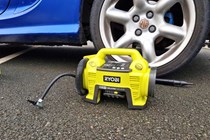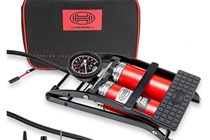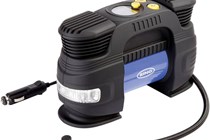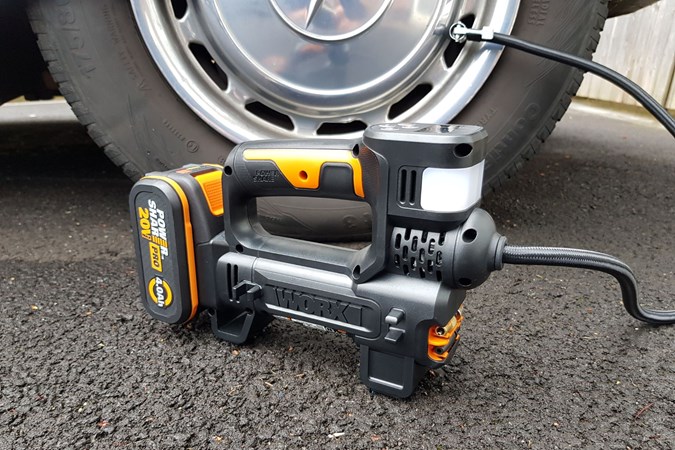Why are tyre inflator compressors so important? Your tyres are the only part of a car that comes into contact with the road, so it’s vitally important to keep the rings of rubber in optimum condition. Even the best tyres available must have a minimum tread depth of 1.6mm in the UK. It’s your responsibility to ensure tyres are in good health, which includes inflating them to the recommended pressure, as outlined in your vehicle handbook.
A tyre will naturally lose air over time, but a slow puncture or porous alloy wheels will result in a slower loss of pressure. You’ll also find that the recommended tyre pressures are different when your car is loaded to the rafters with holiday gear. It’s for these reasons that tyre inflator compressors should be a must-have rather than a nice-to-have accessory.
It is certainly worth noting that under-inflated tyres roll on to have other effects, too. Under-inflated tyres increase rolling resistance, which simultaneously makes your engine work harder and increases fuel consumption. Under-inflated tyres also cause uneven wear on the tyre tread and can have a detrimental effect on braking performance. Hopefully, the cause of the under-inflated tyre won’t require the use of some tyre sealant. But you should always keep monitoring your rubber.
The best tyre inflator compressors tested 2025 at a glance
Much like the plethora of tyres on offer, from all-season tyres to winters, there are hundreds of tyre inflator compressors to choose from. You might be feeling under pressure when it comes to selecting the best one, from basic foot-operated pumps, to the kind of machines that wouldn’t look out of place in the back of a breakdown service van, there are tyre inflators to suit all budgets.
How we tested the tyre inflators
The tyre inflators were tested using a method that reflects how an everyday person would use them on their driveway or on the street. We used the recommended tyre pressures from the cars’ instruction manuals before setting that as a target on each inflator, where possible.
In our recent updated test – to which we brought in the Ryobi inflator – we used an MG TF sports car that was bought by the editorial team for a budget vehicle test. Opening up the owners manual reveals that the front and rear tyres are supposed to be different sizes. However, at a point in this car’s life, someone fitted a full set of larger rear tyres all-round the vehicle. This means our target PSI figure will be the same throughout the test.
For the MG, therefore, the target pressure would be 36PSI all-round – converted from 2.5 BAR. For my Mercedes, which was the subject of earlier tests at home, those would become 28PSI at the front and 32 at the rear. We chose PSI over BAR because these measurements are commonly used with British users, although if you prefer to use BAR as stated in your manufacturers’ handbooks, the machines will accommodate those numbers.
Before putting your tyre inflator into action, check what size tyres your car has and make sure you have the correct pressure figures for it. This is essential, especially if the wheels and tyres on your vehicle are not listed in the owner’s handbook.
What we look for in tyre inflators
Primarily, ease of use is key to a successful machine. If it’s a tyre inflator in which you immediately go to when you just want to top up the air, it receives points. Of course, more powerful machines are going to be a bit more complex, but ultimately, simplicity is our target. Secondly, inflation speed. You might feel the need to top up your tyres’ PSI before a long drive, so it’s nice to be able to have a machine that’ll speedily compress air into the tyres, so you have more time for packing or whatever else.
Although not completely essential, added features are a bonus that makes a tyre inflator a unique one. Some have other functions such as torches, USB ports, and even deflators. Value for money is another aspect we usually look for in tests. Although there are price differences between the tyre inflators we tested, we believe these are justified, as each one performed differently in its own way.
The best tyre inflator compressors tested 2025
The best tyre inflator compressor
What struck me immediately was just how quickly it goes about topping up air in a tyre. From an indicated 30psi to the recommended 32, said top up took less than a minute before the machine automatically stopped at the correct figure. This is different-worldly to the little AA compressor, which would usually take a couple of minutes to gain the same amount of air.
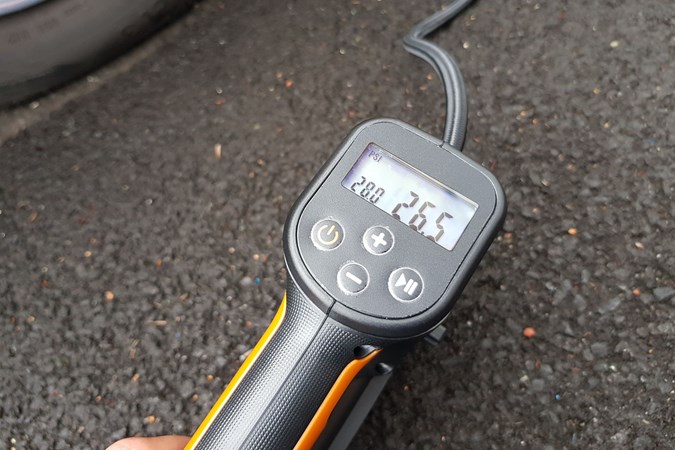
What's more, the WX092.9 is no heavyweight either; I'm keeping it in the boot of my car as it only weighs 950g (without the battery). But despite that, it also feels sturdy and well-built. It matches the typical Worx quality that we've found in the brand's cordless pressure washer and cordless wet and dry vacuum cleaner. I've been running it with the 4.0Ah battery, which was taken out of the vacuum we had on test, and I can confirm that it runs pretty efficiently, albeit not as long-lasting as it performs on the pressure washer.
It's also very easy to hook up the valve to the connector and lock it in place. Sussing out the units you want to use is a bit more fiddly than it needs to be, but once you've found the pressure units you want, you won't have to change them again. Overall, this inflator is a standout piece in my car maintenance kit. I just wish it were a bit quieter so I could use it on early morning journeys without waking the neighbours.
Review by Aaron Hussain
Pros
- Inflates tyres very quickly
- Durable build quality and construction
- 18 and 20V batteries compatible with other Worx tools
Cons
- Battery performance differs between tool to tool
- Setting up the preferred units is a bit of a fuss
| Power type | Battery |
| Dimensions | 33 x 23.8 x 8.4cm |
| Weight | 950g (without battery) |
| Other features | Torch |
Editor's pick


The pros are strong: chiefly, it's the most stable out of the three when standing up, whereas the Worx and Ring had a slight tendency to fall over. It also inflated immensely quickly at more or less the same rate as the Worx inflator. I'd class the Ryobi and Worx as close competitors, and the performance between the two is pretty much tied.
What I didn't approve of however, is that you manually have to set the automatic shut-off. This would've been fine if the controls were obvious, but the control panel on this inflator is a bit fiddly to suss through. However, points are won back for how easy it is to store; you can leave the battery installed if you want and just place the inflator back in the box.
Review by Aaron Hussain
Pros
- Powerful tool designed for many inflation purposes
- Lightweight for its size at just 1.6kg (without battery)
- Batteries are compatible across the Ryobi tool range
Cons
- Battery not included and a 5.0Ah one costs £86 extra
- The automatic cut-off has to be set manually
| Power type | Battery |
| Dimensions | 26.7 x 169 x 200cm |
| Weight | 1.9kg (without battery included) |
| Other features | Deflator, inflatable accessory hose |
Best heavy duty tyre inflator
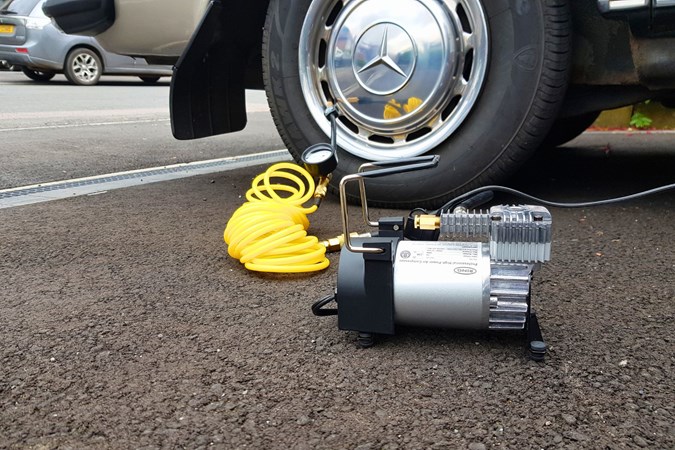

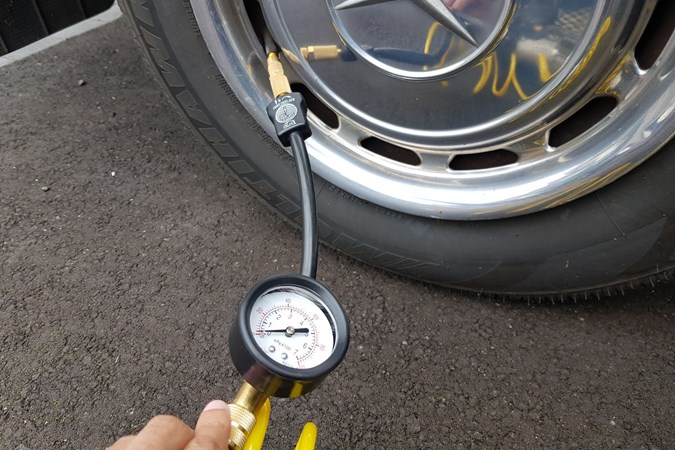
The build quality of the item is up there with some truly professional equipment. The handle is reassuringly strong, and it has a handy pressure gauge, which is clear to read with its black arrow on a white dial. Oh, and the yellow cable stretches out far enough to cover a limousine. However, connecting the cable to the compressor with the brass ends requires some great strength. You really have to check to make sure it's connected properly, as there is no satisfying click to listen out for. The pull-back trigger-like mechanism feels like it's magnetic, but not the kind you wish for.
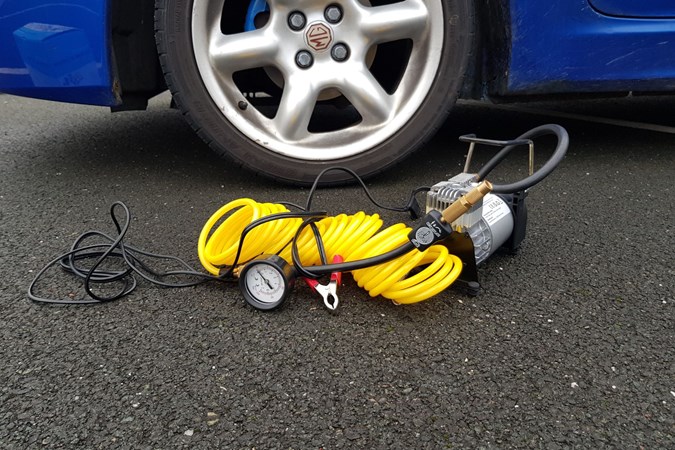
Nevertheless, once you've wrestled the fidgety ends of the device, it's nothing short of amazing at its job. The time cut by inflating tyres with this device is substantial compared to the AA compressor. With that said, however, lifting up the bonnet and connecting two clamps is just not as handy nor as easy to use as a simpler, cable-operated tyre compressor that plugs into your 12V socket/cigarette lighter. But the outright power, build quality, and efficiency of the machine is its main selling point.
Review by Aaron Hussain
Pros
- Very fast inflation that obliterates cheaper devices
- Great build quality and feel of the materials
- The gauge is well-engineered
Cons
- The battery clamp procedure is fidgety compared to a simple socket-powered compressor
- Is a bit fiddly to try and put together
| Power type | Crocodile clips/battery terminals |
| Dimensions | 34 x 20.6 x 23.2cm |
| Weight | 3.7kg |
| Other features | None |
The best compact tyre inflator compressor
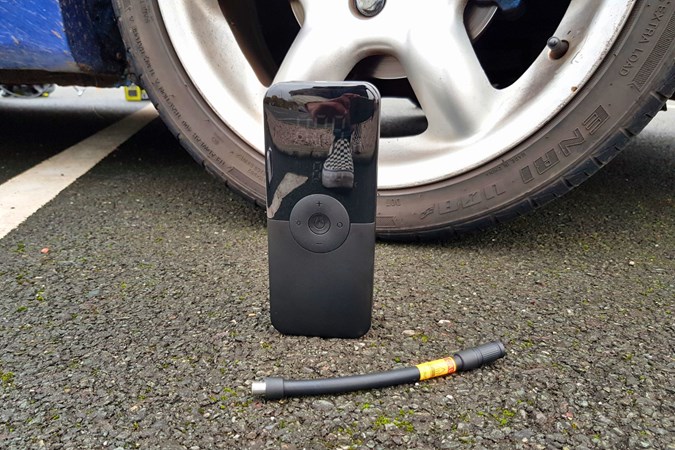

As a tyre inflator, then, how did it get on? Well, the inflation speed itself was slow - very slow. Whereas the others managed to inflate four or five PSI into the tyres in a matter of seconds, it took a good couple of minutes with this device. It's also very noisy and would make a noticeable racket if you lived in a quiet neighbourhood.
However, the big pros that balance it out are that it's a compact device that, if you wanted, could be carried around in your coat pocket or bag. And for the price, there's little to complain about when it undercuts the other test subjects on price. You just have to deal with the lesser performance and engineering quality.
Review by Aaron Hussain
Pros
- Exceedingly good value for money
- Compact device that's very portable
- Doubles as a power bank that can charge your phone
Cons
- The rate of inflation is very slow
- The device is very noisy
| Power type | Cordless |
| Dimensions | 4.4 x 6.6 x 16cm |
| Weight | 550g |
| Other features | Torch, power bank |
Best budget tyre inflator compressor

It does make quite a racket when inflating the tyre, and the needle does shake, which may affect an accurate reading. And it's clearly built down to a very low price, based on the feel of its cheap plastic body. But if you don't wish to spend too much on a tyre compressor, this will be your ideal companion. The wire (that connects to the socket) is three metres long, so it can easily reach each wheel. When plugged into a socket, it makes it a doddle to move around, even with larger vehicles. The cord between the compressor and the valve fastener, though, is so short that you have to hold it until the air inflates, which isn't ideal.
Review by Aaron Hussain
Pros
- Incredibly effective compressor that inflates tyres quickly
- Very easy to use, thanks to just one button
- Very good value for money at just over £14
Cons
- Makes a loud noise when compressing
- Short air cord which means the unit has to be held when in use
| Power type | Corded |
| Dimensions | 11 x 5 x 13cm |
| Weight | 299g |
| Other features | None |
Best Ring Automotive tyre inflator for camping
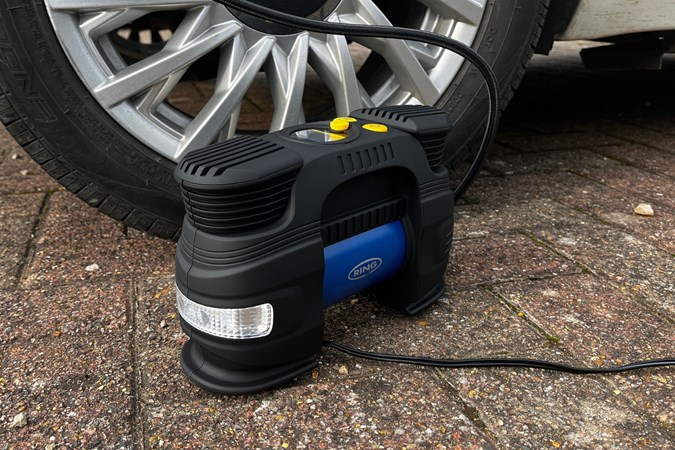

The RAC830 impressed with its speed, taking just a few seconds to top up a set of 205/55 R16 tyres. It did produce a fair amount of noise, though not to an unbearable level. There is one drawback: the valve allowed a brief burst of depressurisation each time the Ring was disconnected.
Another big plus point is the cable management system. The airline wraps neatly around the top while the 3.5-metre power cable neatly slips around the base of the unit. It allows the device to be neatly stored away in the storage bag.
The chief downsides to the device are the price and its rather large dimensions in a world of glovebox-sized options. Still, if you have the space in your boot and want a well-made, high-performance tyre inflator, it'll certainly suit you.
Review by Ryan Gilmore
Pros
- Fast inflation, which is great if you're in a rush to get going
- Tidy cable management system compared to other units, keeping things tidy and organised
- Very simple to operate, which improves approachability
Cons
- Relatively bulky, which can make storage slightly tricky
- Doesn't quite represent as good value as some others
| Dimensions | 17.2 x 26 x 12.8cm |
| Weight | 2.7kg |
| Cable length | 3.5m |
| Hose length | 0.85m |
| Auto stop | Yes |
| LCD display | Yes |
| LED light | Yes |
| Extra attachments | 3 |
Best quality cordless tyre inflator
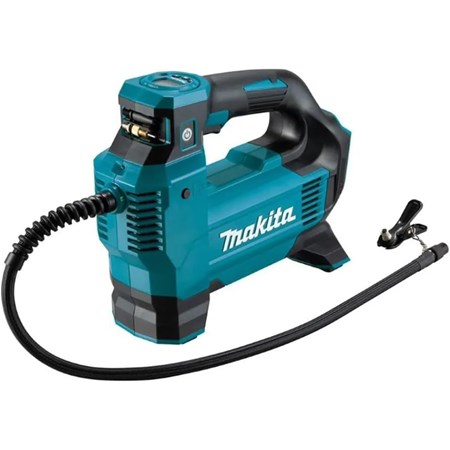

Nevertheless, with a maximum delivery of 161PSI, it's a very useful inflator as it's battery-powered, has a 65cm hose, an auto-stop function, and a pressure pre-set. Unfortunately, the battery and charger aren't included with this purchase, and a 5.0Ah Makita battery is nearly £100 on top of the machine.
Pros
- Clever, yet very simple features like pre-set and auto-stop
- 65cm hose makes it easy to hold and position in place
- Great build quality, as per Makita products
Cons
- Battery and charger not included
| Power type | Battery |
| Dimensions | 20.3 x 7.6 x 27.3cm |
| Weight | 2kg (without battery) |
| Other features | Three inflation modes |
Best foot pump tyre inflator
They also tend to move about when you're in mid-pump, which is far from ideal. This German unit is stable, heavy-duty, and has a foot pump you can pass on to your grandchildren. The double-cylinder design allows for relatively efficient inflation, too, provided your fitness is up to it.
Pros
- A more reliable source of air that doesn't require cords or batteries
- Pretty good build quality
- Rubber pedal for better grip
Cons
- Much harder work than an electric compressor
| Power type | Foot |
| Dimensions | 29 x 9 x 13cm |
| Weight | 2.1kg |
| Other features | None |
FAQs and what to consider when choosing a tyre inflator compressor
-
Do you need the engine running to use a tyre inflator?
If the tyre inflator compressor has a cord that plugs into a socket, yes. These work by having continuous power fed to them by the car's socket - or cigarette lighter - while the engine is running. Cordless inflators, however, don't need the engine's power as they rely on battery power to compress the air and feed it into your tyres.
In the case of the Ring RAC900 we tested, it needs a pair of battery terminals to power the thing. You can use a separate battery or indeed your car's one to power it. It is a bit of a faff over a simple cordless unit, though. -
Are tyre inflator compressors worth it?
Put simply, investing in your own compressor has a host of benefits waiting for you. Filling up a tyre with a petrol station compressor may only cost a couple of quid, but there's the trouble of having to drive out, potentially wait for others, and then you're hit with a time limit of how long you can use the things for.
With your own personal tyre inflator, you don't have to worry about any of that. You can keep a cordless one in the back of your car, and assuming the battery is charged, it's there for you when you need it in a remote area when travelling. -
How do I choose a tyre inflator compressor?
Mid-range tyre inflator compressors like the Ring RAC830 is perfect for most people. They are usually better quality and more powerful than cheaper inflators that come as part of tyre repair kits. However, for compactness and value alone, smaller, cheaper compressors such as AA's unit are great for most situations and can easily be stored in the boot of your vehicle. To use, you simply remove the dust cap from the tyre valve and attach the hose to the inflator. It's then a case of setting the desired pressure and allowing the unit to do its job. If the system has an automatic cut-off, it will stop at the correct pressure, so you simply remove the hose and put the dust cover back on.
A tyre with the incorrect pressure could reduce your car's fuel efficiency by around three per cent, so it pays to get it right. You will also improve your car's braking and handling performance. Timing is one to consider, too, whether it's an analogue or digital tyre inflator. Some tyre inflators will fill a tyre from empty in four to five minutes, while others will complete the task in 90 seconds. And it's worth having a cable long enough to fill the tyres in one go as well.
Whilst on the topic of moving it around, consider things like the quality of the item itself. These include the plastics used and even the vibration. Cheaper units make loud rattling sounds, whereas more premium examples are quieter and smoother in their operation. So, having a compressor that doesn't make a loud noise is also a great bonus. Once correctly inflated, it's always worth checking your tread using a tread depth gauge. You will fail an MOT if a tyre tread depth isn't 1.6mm all round. -
What is the best portable tyre inflator?
Our pick of the lot has to be the Worx WX092.9. If you have other Worx tools that have the 2.0 and 4.0Ah batteries, they will fit directly onto it - and it's a great thing to have with you on trips in case you need to top up the tyre pressures.
-
What happens if my tyres are over-inflated?
Simply put, they'll wear out more quickly. Over-inflated tyres have less contact on the road than those at the recommended pressures, so all the road-holding is dependent on that section of tyre - particularly the centre section. The outer edges of over-inflated tyres will look fine, but that's because they've had little, if not no contact with the road.
-
What happens if my tyres are under-inflated?
Primarily, this increases rolling resistance - meaning that your vehicle is using more energy to move along and roll the wheels. Under-inflated tyres not only increases fuel consumption, but causes you to have less control of the vehicle than you should.
For example, steering will be more wayward, braking abilities will be compromised, and the car will be harder to keep in a straight line. You should check your tyre pressures every few weeks and use your tyre inflator accordingly.
Sign up to the Parkers Newsletter to keep up to date with more of the latest reviews, news, and recommendations from the Parkers team.
Just so you know, we may receive a commission or other compensation from the links on this website - read why you should trust us.


